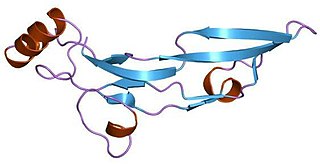
Growth/differentiation factor 9 is a protein that in humans is encoded by the GDF9 gene.

Bone morphogenetic protein 15 (BMP-15) is a protein that in humans is encoded by the BMP15 gene. It is involved in folliculogenesis, the process in which primordial follicles develop into pre-ovulatory follicles.

Bone morphogenetic protein 10 (BMP10) is a protein that in humans is encoded by the BMP10 gene.

Bone morphogenetic protein 8B is a protein that in humans is encoded by the BMP8B gene.

Bone morphogenetic protein 6 is a protein that in humans is encoded by the BMP6 gene.

Bone morphogenetic protein 5 is a protein that in humans is encoded by the BMP5 gene.

Bone morphogenetic protein 3, also known as osteogenin, is a protein in humans that is encoded by the BMP3 gene.
The transforming growth factor beta (TGFB) signaling pathway is involved in many cellular processes in both the adult organism and the developing embryo including cell growth, cell differentiation, cell migration, apoptosis, cellular homeostasis and other cellular functions. The TGFB signaling pathways are conserved. In spite of the wide range of cellular processes that the TGFβ signaling pathway regulates, the process is relatively simple. TGFβ superfamily ligands bind to a type II receptor, which recruits and phosphorylates a type I receptor. The type I receptor then phosphorylates receptor-regulated SMADs (R-SMADs) which can now bind the coSMAD SMAD4. R-SMAD/coSMAD complexes accumulate in the nucleus where they act as transcription factors and participate in the regulation of target gene expression.

Bone morphogenetic protein receptor type II or BMPR2 is a serine/threonine receptor kinase. It binds Bone morphogenetic proteins, members of the TGF beta superfamily of ligands, which are involved in paracrine signalling. BMPs are involved in a host of cellular functions including osteogenesis, cell growth and cell differentiation. Signaling in the BMP pathway begins with the binding of a BMP to the type II receptor. This causes the recruitment of a BMP type I receptor, which it phosphorylates. The Type I receptor phosphorylates an R-SMAD a transcriptional regulator.

The bone morphogenetic protein receptor, type IA also known as BMPR1A is a protein which in humans is encoded by the BMPR1A gene. BMPR1A has also been designated as CD292.

The transforming growth factor beta (TGF-β) family is a large group of structurally related cell regulatory proteins that was named after its first member, TGF-β1, originally described in 1983. They interact with TGF-beta receptors.
Growth differentiation factors (GDFs) are a subfamily of proteins belonging to the transforming growth factor beta superfamily that have functions predominantly in development.

Growth differentiation factor 1 (GDF1) is a protein that in humans is encoded by the GDF1 gene.

Growth differentiation factor 2 (GDF2) also known as bone morphogenetic protein (BMP)-9 is a protein that in humans is encoded by the GDF2 gene. GDF2 belongs to the transforming growth factor beta superfamily.

Growth differentiation factor-3 (GDF3), also known as Vg-related gene 2 (Vgr-2) is protein that in humans is encoded by the GDF3 gene. GDF3 belongs to the transforming growth factor beta (TGF-β) superfamily. It has high similarity to other TGF-β superfamily members including Vg1 and GDF1.

Growth/differentiation factor 5 is a protein that in humans is encoded by the GDF5 gene.

Growth differentiation factor 6 (GDF6) is a protein that in humans is encoded by the GDF6 gene.

Growth differentiation factor 7 (GDF7) is a protein that in humans is encoded by the GDF7 gene.

Growth differentiation factor 11 (GDF11) also known as bone morphogenetic protein 11 (BMP-11) is a protein that in humans is encoded by the growth differentiation factor 11 gene. GDF11 is a member of the Transforming growth factor beta family.

Bone morphogenetic protein receptor type-1B also known as CDw293 is a protein that in humans is encoded by the BMPR1B gene.

















